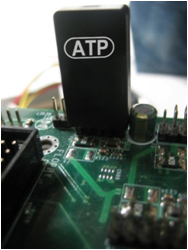This Internal SSD Connects Via 10-Pin USB Port
It's a SSD that connects to the 10-pin USB port located on the motherboard.
TechPowerUp points the way to a rather cool SLC NAND-based solid state drive that connects to an empty, 10-pin internal USB port located on the motherboard.
Measuring 8.2 (L) x 15.3 (W) x 6.2 (H) mm, the SIP eUSB SSD mounts on one USB internal header cluster and provides a fixed storage solution ranging from 512 MB to 4 GB. Thanks to USB 2.0, the drive provides transfer speeds of up to 30 Mb/s, and can be used as a bootable drive in servers or embedded and IPC systems. It also has an endurance of >2,000,000 cycles, and should retain user data for around 10 years.
"It utilizes advanced Static and Dynamic Wear leveling to increase endurance and built in error correction for data integrity," said ATP Electronics. "Using an industry leading SIP (System In Package) technology manufacturing process which encapsulates all exposed components and points of failure, the ATP SIP eUSB SSD is fully water/moisture proof, dust proof, shock proof, vibration proof and ESD (Electro-Static Discharge) proof."
Currently pricing and availability isn't known, however ATP Electronics lists Wal-Mart, Target, and even Belk as suppliers.
Get Tom's Hardware's best news and in-depth reviews, straight to your inbox.

Kevin Parrish has over a decade of experience as a writer, editor, and product tester. His work focused on computer hardware, networking equipment, smartphones, tablets, gaming consoles, and other internet-connected devices. His work has appeared in Tom's Hardware, Tom's Guide, Maximum PC, Digital Trends, Android Authority, How-To Geek, Lifewire, and others.
-
krotkdm Hmmm, is it MBs or mbs?Reply
Per http://en.wikipedia.org/wiki/Data_rate_units, 'b' stands for 'bit' and 'B' stands for 'byte'. However, it has been suggested that 'bit' should not be abbreviated since it's already an abbreviation for "binary digit", and the difference between bit and byte can lead to confusion. In the context of data rate units, one byte refers to 8 bits.
According to the manufacturer's website, MBytes/sec -
hellwig You are all looking at this the wrong way. This is a solution for kiosks that might normally use Compact Flash plugged directly into an IDE (PATA) port. Since IDE is going the way of the Dodo, vendors need other solutions for small, reliable storage. Since I don't think any existing flash solution utilizes the SATA protocol (CF natively used IDE), this is a viable solution for people looking to update their systems.Reply
Oh crap, I guess I missed the very last line. If this is for kiosks, why are they selling it at Walmart?
Ok, new solution. This is for Windows Readyboost. I mean, I have an old 2GB flash drive sticking out the back of my computer for just this purpose. It might be nice (if the price is right) to instead house that flash drive internally where it wasn't at risk of falling out or breaking off. Yeah, that sounds reasonable. -
tpi2007 I don't get something here: it it connects to a 10-pin connector on the Motherboard, it means it's effectively occupying 2 usb headers.Reply
In that case, why does it only have the performance of a single connection (30mb/s) ?
I was expecting something that could use the two ports together like some kind of RAID and speed up the reading and writing process. Like it is, it's just a high quality usb pen with differet contacts, but taking up twice the hearders without any performance improvment. I'll pass that.
